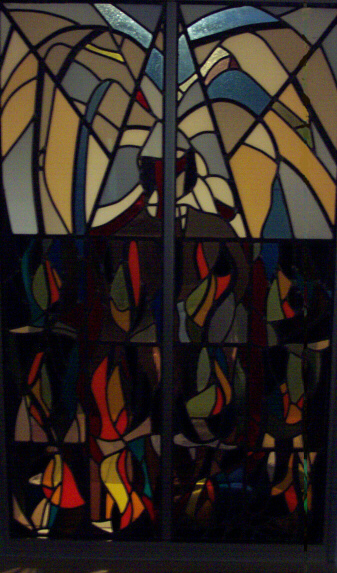
The Designers
The Windows were designed by three men in 1976: Charles Devillier, Paul A. Dufour and Samuel J. Corso, under the auspices of Dufour Glass Studio, Ltd. (Now, Dufour-Corso Studios, Ltd.), 812 Main Street, Baton Rouge, LA 70802. Paul Dufour was professor of Fine Arts at Louisiana State University and retired as professor emeritus in 1985.
Orientation
Standing in the pulpit, looking at the double doors that open out to the front yard of the Church, on Jackson Street, one sees on the left three windows on the Ida Street side of the Sanctuary (1-3), with one at the left rear (4), looking out to the Handicap Entrance. On the right, there are three windows on the Courtyard side (5-7), with one at the right rear (8), looking out to the Entrance from the Sunday School wing. In the center of the Church, above the balcony, is the ninth window (9).
The Basic Theme
The Basic Theme of the Windows is the motif of Creation, the Fall and Redemption in Jesus Christ.
Window One: The Creation Window

As we begin our tour of the nine windows, at the front of the Sanctuary on Ida Street side, we come to the Creation Window. One can detect the six days of Creation in the upper part of the window. On day one God created the light (Genesis 1:3); this is represented by the contrasting light and dark colors in the lower left section of the upper part. To the right is day two, the sky and water (1:6); directly above is day three, land and vegetation (1:9_11). To its left is day four, when God created the sun, moon and planets (1:14); directly above is day five, where one can detect bird like shapes (1:21). On the sixth day, God created humankind; this panel, located in the upper right hand corner shows a blonde haired woman and a brown haired man. Tying the window together is the tree of life, in whose branches are the six days of creation. Also visible is the tip of a triangle pointing down: God's entering into time and space on our behalf. This triangular device is found in a number of the windows.
Window Two: The Window of Death

As we move to the right, we come to the window that represents the Fall of our first parents into sin. Upon reflection one can discern in the Window of Death elements from Genesis three: the serpent at the bottom, the wings of the cherub who separated fallen humankind from a holy God and his Paradise.
Window Three: The Window of the Law

God revealed himself at the Burning Bush and on Mount Sinai. In the flames of the Bush, the two tablets of the Ten Commandments are visible in the Window of the Law.
Window Four: The Holocaust Window

Moving to the back of the Sanctuary, one comes to the Holocaust Window; its dominant hue is white, symbolizing innocence. Above is the smoke of the burnt offering, and running down the white is the crimson blood that was shed as a foreshadowing of the sacrifice of Jesus, the Lamb of God who takes away the sins of the world.
Window Five: The Incarnation Window

Moving back to the front of the sanctuary, on the Courtyard side, one comes to the Incarnation Window, the one that symbolizes the birth of the Lord Jesus. Two triangles connect at the base, symbolizing that Jesus is truly God and truly human in one Person, the Son of the Father. In the lower left are images of Jesus' childhood, such as carpenter's tools. Also, one is introduced to the mandorla, the almond shaped circle that is used to symbolize Jesus.
Window Six: The Crucifixion Window

Next one comes to the Crucifixion Window. Christ sheds his blood not only for humankind but to redeem the green and brown earth from Adam's curse. Again, one notices the mandorla and the triangles: God and man are reconciled in the person of Jesus Christ.
Window Seven: The Resurrection Window

The Resurrection Window symbolizes the Lord Jesus' resurrection victory over death by means of the Phoenix, the double-headed bird of Egyptian mythology that was consumed in fire and rose from its ashes every five hundred years. Again, one observes not only the triangular shapes but the mandorla as well.
Window Eight: The Pentecost Window

At the back of the Sanctuary, facing the vestibule, is the Pentecost Window. In Acts two, the Holy Spirit came as a rushing, mighty wind as he was poured out on the Church and manifested himself with tongues of fire. The common motifs of the mandorla and triangle are visible, too.
Window Nine: The Consummation Window

Above the balcony is the Consummation Window. The last book of the Bible, the Revelation, has as its title in Greek, Apocalypsis, which literally means "unveiling." Christians throughout the ages have confessed that Jesus will come again. The purple of the conquering King coming on glory clouds, as well as the triangle and mandorla motifs appear within the dominant motif of the veil being parted.